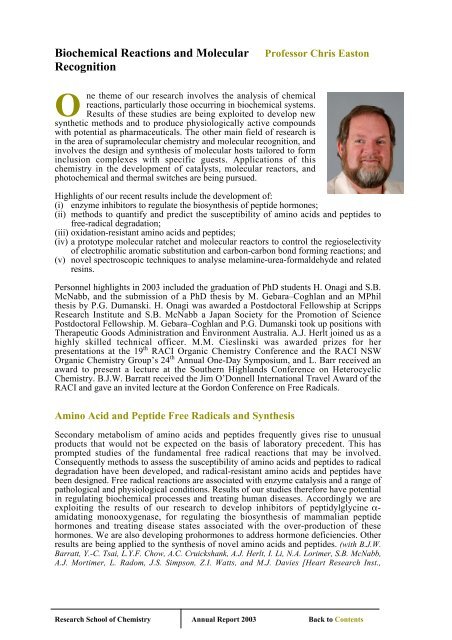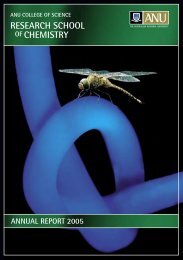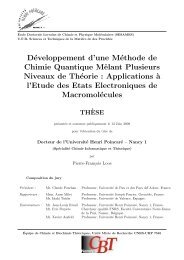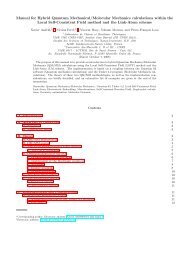Biochemical Reactions and Molecular Professor Chris Easton ...
Biochemical Reactions and Molecular Professor Chris Easton ...
Biochemical Reactions and Molecular Professor Chris Easton ...
Create successful ePaper yourself
Turn your PDF publications into a flip-book with our unique Google optimized e-Paper software.
<strong>Biochemical</strong> <strong>Reactions</strong> <strong>and</strong> <strong>Molecular</strong><br />
Recognition<br />
<strong>Professor</strong> <strong>Chris</strong> <strong>Easton</strong><br />
O<br />
ne theme of our research involves the analysis of chemical<br />
reactions, particularly those occurring in biochemical systems.<br />
Results of these studies are being exploited to develop new<br />
synthetic methods <strong>and</strong> to produce physiologically active compounds<br />
with potential as pharmaceuticals. The other main field of research is<br />
in the area of supramolecular chemistry <strong>and</strong> molecular recognition, <strong>and</strong><br />
involves the design <strong>and</strong> synthesis of molecular hosts tailored to form<br />
inclusion complexes with specific guests. Applications of this<br />
chemistry in the development of catalysts, molecular reactors, <strong>and</strong><br />
photochemical <strong>and</strong> thermal switches are being pursued.<br />
Highlights of our recent results include the development of:<br />
(i) enzyme inhibitors to regulate the biosynthesis of peptide hormones;<br />
(ii) methods to quantify <strong>and</strong> predict the susceptibility of amino acids <strong>and</strong> peptides to<br />
free-radical degradation;<br />
(iii) oxidation-resistant amino acids <strong>and</strong> peptides;<br />
(iv) a prototype molecular ratchet <strong>and</strong> molecular reactors to control the regioselectivity<br />
of electrophilic aromatic substitution <strong>and</strong> carbon-carbon bond forming reactions; <strong>and</strong><br />
(v) novel spectroscopic techniques to analyse melamine-urea-formaldehyde <strong>and</strong> related<br />
resins.<br />
Personnel highlights in 2003 included the graduation of PhD students H. Onagi <strong>and</strong> S.B.<br />
McNabb, <strong>and</strong> the submission of a PhD thesis by M. Gebara–Coghlan <strong>and</strong> an MPhil<br />
thesis by P.G. Dumanski. H. Onagi was awarded a Postdoctoral Fellowship at Scripps<br />
Research Institute <strong>and</strong> S.B. McNabb a Japan Society for the Promotion of Science<br />
Postdoctoral Fellowship. M. Gebara–Coghlan <strong>and</strong> P.G. Dumanski took up positions with<br />
Therapeutic Goods Administration <strong>and</strong> Environment Australia. A.J. Herlt joined us as a<br />
highly skilled technical officer. M.M. Cieslinski was awarded prizes for her<br />
presentations at the 19 th RACI Organic Chemistry Conference <strong>and</strong> the RACI NSW<br />
Organic Chemistry Group’s 24 th Annual One-Day Symposium, <strong>and</strong> L. Barr received an<br />
award to present a lecture at the Southern Highl<strong>and</strong>s Conference on Heterocyclic<br />
Chemistry. B.J.W. Barratt received the Jim O’Donnell International Travel Award of the<br />
RACI <strong>and</strong> gave an invited lecture at the Gordon Conference on Free Radicals.<br />
Amino Acid <strong>and</strong> Peptide Free Radicals <strong>and</strong> Synthesis<br />
Secondary metabolism of amino acids <strong>and</strong> peptides frequently gives rise to unusual<br />
products that would not be expected on the basis of laboratory precedent. This has<br />
prompted studies of the fundamental free radical reactions that may be involved.<br />
Consequently methods to assess the susceptibility of amino acids <strong>and</strong> peptides to radical<br />
degradation have been developed, <strong>and</strong> radical-resistant amino acids <strong>and</strong> peptides have<br />
been designed. Free radical reactions are associated with enzyme catalysis <strong>and</strong> a range of<br />
pathological <strong>and</strong> physiological conditions. Results of our studies therefore have potential<br />
in regulating biochemical processes <strong>and</strong> treating human diseases. Accordingly we are<br />
exploiting the results of our research to develop inhibitors of peptidylglycine α-<br />
amidating monooxygenase, for regulating the biosynthesis of mammalian peptide<br />
hormones <strong>and</strong> treating disease states associated with the over-production of these<br />
hormones. We are also developing prohormones to address hormone deficiencies. Other<br />
results are being applied to the synthesis of novel amino acids <strong>and</strong> peptides. (with B.J.W.<br />
Barratt, Y.-C. Tsai, L.Y.F. Chow, A.C. Cruickshank, A.J. Herlt, I. Li, N.A. Lorimer, S.B. McNabb,<br />
A.J. Mortimer, L. Radom, J.S. Simpson, Z.I. Watts, <strong>and</strong> M.J. Davies [Heart Research Inst.,<br />
Research School of Chemistry Annual Report 2003 Back to Contents
Organic Chemistry<br />
Sydney], A. Rauk [U. Calgary, Canada], A. Wright, M. Taylor [ANUTECH Pty Ltd], [Business<br />
ACT])<br />
Supramolecular Chemistry <strong>and</strong> <strong>Molecular</strong> Recognition<br />
This work exploits cyclodextrins as the basis for the construction of molecular hosts <strong>and</strong><br />
involves the preassembly of molecules to:<br />
(i) alter their behaviour <strong>and</strong> properties;<br />
(ii) produce materials for chemical processing; <strong>and</strong><br />
(iii) construct molecular devices.<br />
Our early work in this area resulted in pharmaceutical formulations that are in everyday<br />
clinical use worldwide. In more recent studies modified cyclodextrins are being<br />
developed <strong>and</strong> exploited as molecular scaffolds for the construction of catalysts,<br />
molecular switches, <strong>and</strong> photochemical devices, <strong>and</strong> as templates to control the regio<strong>and</strong><br />
stereo-selectivity of reactions of included guest molecules. We have been able to<br />
design <strong>and</strong> prepare modified cyclodextrin hosts that display increased molecular<br />
recognition on binding of guest molecules. By attaching reactive groups to cyclodextrins<br />
it has also been possible to produce catalysts with applications in chemical process<br />
technology. Another application of cyclodextrins involves their use to control the<br />
assembly of the components of chemical reactions, to facilitate the reactions <strong>and</strong> alter the<br />
outcomes. The cyclodextrins thereby act as reaction vessels, but at the molecular level.<br />
In this regard, we have developed demonstration systems to alter by more than 4000<br />
times the ratio of indigo <strong>and</strong> indirubin produced in competing condensation reactions <strong>and</strong><br />
to reverse the regioselectivity of nitrile oxide cycloaddition processes. The latter<br />
reactions are also markedly accelerated compared to the analogous reactions in free<br />
solution. We have also been exploring the synthesis of cyclodextrin rotaxanes, catenanes,<br />
knots <strong>and</strong> daisy chains of various topologies. Where these have more than one ground<br />
state conformation, <strong>and</strong> the different states can be accessed using external stimuli, they<br />
form the basis of molecular devices such as ratchets <strong>and</strong> motors, temperature <strong>and</strong> light<br />
sensors, photochemical frequency switches <strong>and</strong> molecular tweezers. Crystal structures of<br />
cyclodextrin host-guest complexes <strong>and</strong> rotaxanes show that these may be designed to<br />
exploit the cyclodextrins as insulators of molecular filaments formed by the guests. This<br />
has potential, for example, in the development of microelectronic systems, where the<br />
guests form conducting wires only in one direction. (with L. Barr, M.M. Cieslinski, R.<br />
Dawson, P.G. Dumanski, A.J. Herlt, N.A. Lorimer, H. Onagi, M.-H. San <strong>and</strong> J.S. Simpson, <strong>and</strong><br />
S.F. Lincoln, J.S. Locke, B.L. May [U. Adelaide], G.W. Simpson [CSIRO <strong>Molecular</strong> Science,<br />
Melbourne], R. Faulkner [Australian Vinyls Pty Ltd, Melbourne])<br />
Other Collaborative Research<br />
Another collaboration involves studies of the structure of melamine-urea-formaldehyde<br />
resins, <strong>and</strong> the search for alternative reagents <strong>and</strong> improved processes. We are also<br />
investigating the use of nitrile oxides in the stereocontrolled synthesis of polyfunctional<br />
molecules, particularly in order to develop a synthesis of the triol pharmacophore of the<br />
antioxidant scymnol. Other biochemical molecular recognition processes are also being<br />
studied, including the design <strong>and</strong> development of compounds to inhibit <strong>and</strong> stimulate<br />
ion-flux through calcium ion channels. (with P.A. Coghlan, M. Gebara–Coghlan, M. Nairn,<br />
A. Philbrook, J. K. Robinson, <strong>and</strong> J. Altin [Lipotek Pty Ltd], J.M. Broadbent [McFarlane<br />
Laboratories Pty Ltd, Melbourne], A. Dulhunty, M. Casarotto [JCSMR, ANU], N. Dunlop, G.<br />
Ryan [Orica Ltd <strong>and</strong> the UnIChe program], A. Ferrante, A. Poulos [Adelaide Medical Centre for<br />
Women <strong>and</strong> Children], G.W. Simpson [CSIRO <strong>Molecular</strong> Science, Melbourne])<br />
http://rsc.anu.edu.au/research/easton.php<br />
Research Summary<br />
<strong>Biochemical</strong> <strong>Reactions</strong> <strong>and</strong> <strong>Molecular</strong> Recognition Back to Contents






